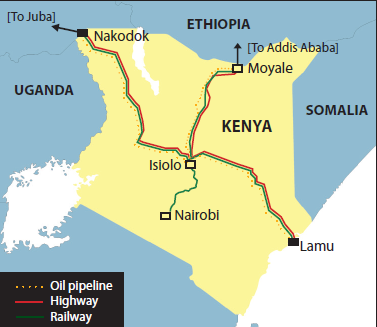|

JPC proposed new airports at Lamu, Isiolo and Lokichokio with Lamu having an international airport, with a combined potential to carry 600,000 passengers per year, more than three times what local airlines carry today. Buses and cars would be ferrying at least a million passengers by 2030 on the planned road network. Currently, there is no tarmac road between Kenya and South Sudan, meaning that road users have to go through Uganda.
The regional countries came onboard with this project seeking alternative routes for their goods. Ethiopia, which has been using the seaport in Djibouti, is eyeing shorter routes to the coast in the event of oil being discovered in its Ogaden region near the border with Somalia. Exploration is currently underway there. Newly independent South Sudan is looking for an alternative oil transportation route due to ongoing conflicts with Khartoum in the north over the black gold. South Sudan split from Sudan last year in July, but has been using the Sudanese seaport of Omdurman.
JPC envisaged that by 2020, there would be at least 3 million tons of goods being imported and 4.7 million tons exported, moving through Lamu port. By 2030, this would rise to 5.1 million tons and 9.3 million tons respectively, said the report.
To boost tourism in the area and take advantage of the UNESCO sites, the development of resort cities are planned at Lamu, Isiolo and Lake Turkana.
Early this year, South Sudan shut down its oil wells after it claimed Sudan had refused to load its oil on their ships. "Shutting down oil pipelines was for a good reason. Sudan had continued to refuse loading our oil on their ships. Sometimes it has refused our ships from docking there," South Sudanese Information Minister Dr. Barnabas Marial Benjamin told journalists in Nairobi in February.
"We are supporting this [Lapsset] because it will bring with it enormous projects like roads, pipelines and railways, facilities which we really need," he said.
Effecting change
Kenya is keen on the project because it wants to open up development in the northern parts of the country, which have been neglected since independence in 1963.
While on a visit to Brussels recently, Kenyan Prime Minister Raila Odinga tried to woo investors, saying Lapsset would give them huge returns as it transforms Africa.
"I am convinced that as a result of Lapsset, trade and investment between our countries will make a quantum leap. Once Lapsset is completed or even concurrently, we will extend the railways and highways beyond South Sudan to the west. Our aim is to construct railways and highways that connect the Indian Ocean and the Atlantic Coast," the PM's press dispatch quoted him as saying.
In a continent whose infrastructure has often frustrated intra-continental trade, the GDP of Africa has stalled at $1 trillion. Trade between Kenya and Ethiopia is under $2 billion per year, according to figures from Kenya's Ministry of Trade.
However, economists say construction of link roads could help to effect change. "Having roads will facilitate growth of intra-Comesa trade. We expect this to grow by at least 25 percent in the first year, and then continue in years to come," said Gabriel Negatu, Managing Director of the Africa Development Bank (AfDB). Comesa is a regional trading bloc involving countries that mostly use Africa's east-coast ports.
AfDB has been one of East Africa's major infrastructure financiers, having pumped at least $1 billion into the region in the last two years alone. AfDB recently gave a further $250 million to complete the construction of a highway between Nairobi and Addis Ababa through Kenya's northern town of Moyale.
(Reporting from Kenya) |